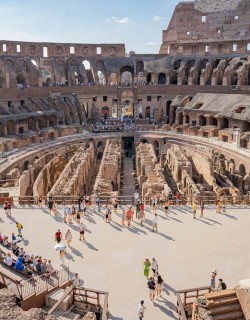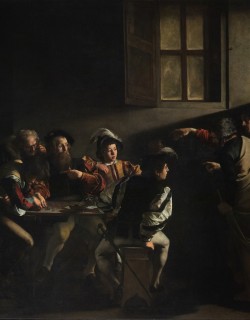Starting this month, visitors to Rome will have the opportunity to visit a long-shuttered treasure: the Farnese Aviaries on the Palatine Hill. For a full thirty years this beautiful example of Renaissance architecture had been closed to the public; now, after a multi-million euro restoration supported by the World Monuments Fund, the spaces have been reopened, offering a wonderful contrast to (and stunning views of) the ruins of the Roman Forum.
The Aviaries are one of the last surviving remnants of the extensive Farnese Gardens (Orti Farnesiani) that once covered much of the Palatine Hill. These were a combination pleasure-retreat and summer residence created for one of the most powerful families of sixteenth-century Rome. Alessandro Farnese was only 14 when he was made cardinal (it helped that his grandfather had just been elected Pope Paul III.) The position was much more than ecclesiastical; it provided access to huge sums of money and allowed the family to construct lavish buildings and art collections.
The main Farnese Palace is right in the middle of Rome - one block south of Campo de’ Fiori - and the Palatine gardens commissioned by the young Cardinal Farnese were intended to be a green and airy retreat from the bustle of the city. In 1550, when construction started, the impressive ruins of the Palatine Hill and the Roman Forum had not yet been excavated, and the whole area would have had the atmosphere of a suburban parkland.
Although the substantial remains of the ancient imperial palaces had not yet been discovered, the area’s connection with the Roman emperors was not forgotten. In choosing the Palatine Hill as the location of his garden-palace, then, Cardinal Farnese wasn’t just occupying a choice piece of real estate; the gardens, constructed where Augustus, Nero and others had lived, put him on a list of very eminent residents and suggested that the Farnese were to be considered a kind of new imperial family.
The surviving structures consist of a series of stepped terraces that rise up the Palatine Hill and link it with the Roman Forum below. At the very top are the twin pavilions/bird-cages that give the Farnese Aviaries their name; although their elaborate wrought-iron domes have been replaced, the grills in the windows of the paired gazebos serve as reminders of the rare and exotic birds that once lived here. The cascade of terraces - the word patio doesn’t do them justice - offer wonderful views and must have hosted some incredible parties.
Surrounding these aviaries are elegant formal gardens, with hedges and orange trees providing a nice bit of green amid the dust and marbles. These are not the original plants, of course, nor quite the original gardens, which had fallen into disrepair first after the last descendants of the Farnese left Rome and later during archaeological explorations. Their current appearance is the work of Giacomo Boni, the great Italian archaeologist and excavator of the Roman Forum; his grave, in the shape of an ancient Roman altar, is at the center of the garden.
Boni made sure to include palm trees and other tropical plants as a nod to the Farnese Gardens’ original contents. It was one of Europe’s first botanical gardens, filled with specimens brought from around the globe, including the newly-discovered continents of the New World. In one part of the complex, the “Giardino della Palma”, visitors could admire exotic plants previously unknown in Italy; one species of acacia - Vachellia farnesiana - takes its name from the family. Perfume-makers still use an extract from this tree; in an obscure nod to this Renaissance garden, it is known to chemists as farnesol.
At the very base of the pavilion, built right into the ruins of the emperor Domitian’s palace, is a shady grotto that must have been (as it continues to be) the perfect respite from the summer heat. Protected from the sun by a series of elegant porticoes, the space is decorated with stones in imitation of stalactites, as if the whole thing was a natural cave. On the inner wall is a mossy fountain that, thanks to the low water-pressure, doesn’t spurt so much as sweat water. This moisture, nonetheless, evaporates in the heat and creates a cooling effect for visitors.
This grotto was once guarded by two marble statues of Dacians, the barbarian people who in antiquity had lived in what is now Romania. This territory had been conquered by the emperor Trajan, and the statues likely came from the massive Forum of Trajan built in his honor, still visible from Via dei Fori Imperiali. When the last member of the Farnese family, Elisabetta, married into the Spanish royal family, these sculptures, like the rest of the Farnese Collection, went to Naples, and are today in the Archaeological Museum of Naples. In celebration of the reopening of the Farnese Gardens, the two Dacians, masterworks of Roman imperial sculpture, have returned home as part of a temporary exhibition.
Another section of the Farnese Gardens on the opposite side of the Palatine that was part of the same restorations has so far not reopened to the public. Allegedly, after all the money spent on restoring its frescoes and installing protective screens, a lack of funds for staff have kept them closed. For now, however, visitors can cool off in the Farnese grotto, enjoy the vista from the terraces, and marvel at how much fun a cardinal could have in the sixteenth century.
When in Rome be one of the first people to experience the recently renovated Farnese Gardens. Join our immersive Colosseum Underground Tour, including the Roman Forum and Palatine Hill, to explore the Farnese Gardens and all the impressive ruins of Ancient Rome. If you’re interested in the Farnese family and Renaissance architecture, you’ll want to try our private Villa Farnesina tour and its frescoes by Raphael.



